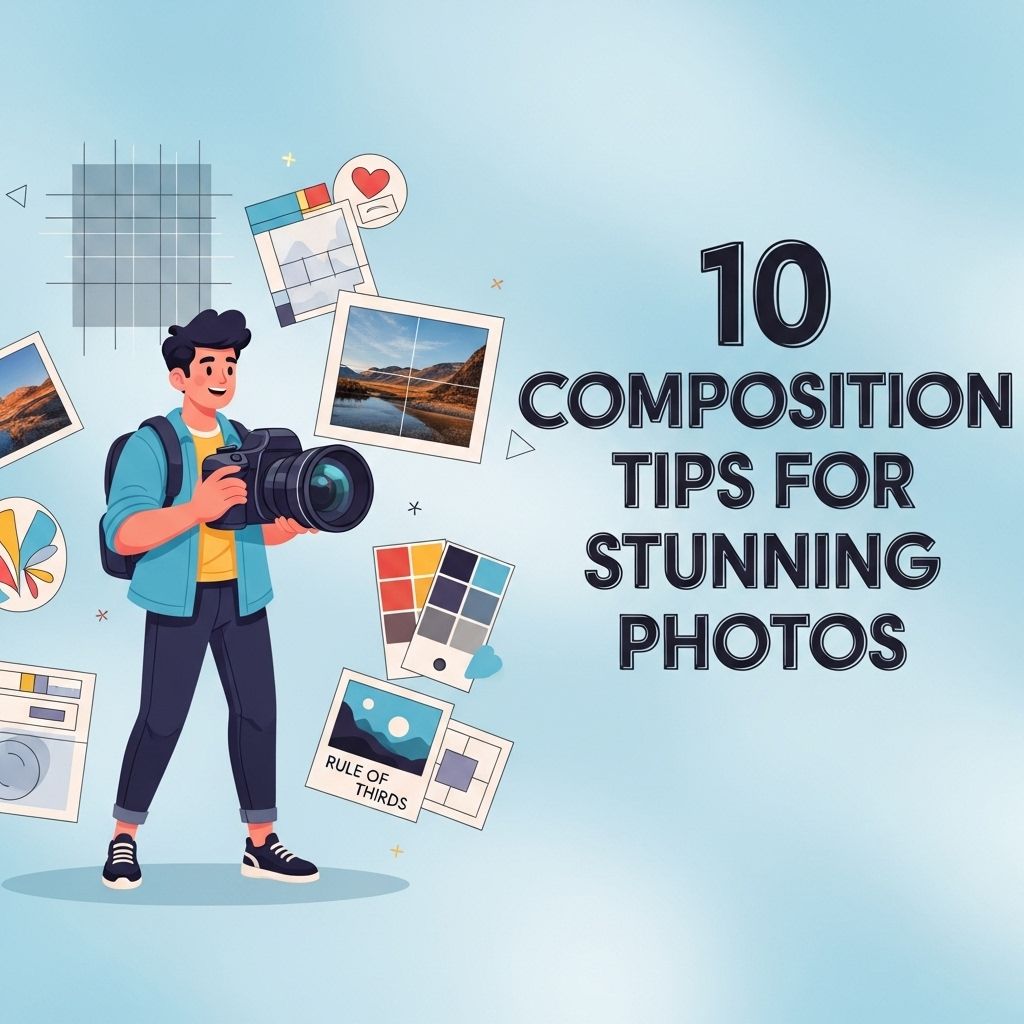Photography is not just about pointing and shooting; it’s an art that requires a keen eye for compositional techniques to create stunning images. Whether you’re an aspiring photographer or someone who enjoys capturing moments with a smartphone, understanding composition can significantly enhance the quality of your photographs. This article will delve into ten essential tips that will elevate your photography game, allowing you to create mesmerizing images that tell a story and evoke emotions.
Understanding the Basics of Composition
Before diving into specific tips, it’s crucial to grasp the fundamental principles of composition that form the foundation of a captivating photograph. These include balance, contrast, focus, and depth. Mastering these principles will help you visualize how to structure your images effectively.
1. The Rule of Thirds
One of the most widely used compositional techniques is the rule of thirds. This guideline suggests dividing your image into a 3×3 grid, creating nine equal parts. The key elements of your scene should be positioned along these lines or at their intersections. This approach helps create a sense of balance and draws the viewer’s eye into the photograph.
How to Apply the Rule of Thirds:
- Enable a grid feature on your camera or smartphone.
- Position key subjects along the lines or at the intersection points.
- Experiment with different placements to find the most compelling arrangement.
2. Leading Lines
Leading lines are elements within your photograph that guide the viewer’s eye towards the focal point. This technique can add depth and dimension to your images, making them more engaging. Roads, rivers, and architectural features often serve as natural leading lines.
Examples of Leading Lines:
- Roads or pathways.
- Fences or railings.
- Bridges or walkways.
3. Framing Your Subject
Framing involves using elements within the scene to create a ‘frame’ around your subject, directing attention to it. This can be achieved using natural elements such as trees, archways, or windows.
Tips for Effective Framing:
- Look for natural frames in your environment.
- Ensure that the frame does not distract from the subject.
- Experiment with different angles and distances.
4. Utilize Negative Space
Negative space refers to the area surrounding your subject. Using negative space can create a sense of minimalism, allowing your subject to breathe within the image. This technique can amplify the impact of your main subject and evoke emotion.
Strategies for Using Negative Space:
- Position your subject off-center to allow for more negative space.
- Choose backgrounds that enhance the focus on your subject.
- Experiment with varying degrees of negative space to find the right balance.
5. Experiment with Perspective
Changing your perspective can drastically alter the mood and impact of your photographs. Instead of always shooting from eye level, try different angles—low, high, or even tilt your camera to create dynamic compositions.
Perspective Techniques:
- Get low to the ground for an unusual vantage point.
- Climb higher to capture a wider view.
- Use a wide-angle lens to exaggerate the perspective.
6. Balancing Elements
Creating balance within your image is vital for achieving a harmonious composition. You can achieve balance either symmetrically, with elements arranged evenly on both sides, or asymmetrically, where different elements are arranged in a way that feels balanced without being identical.
How to Achieve Balance:
- Identify the elements in your scene and analyze their visual weight.
- Arrange subjects and backgrounds to create a balanced composition.
- Use color and light to achieve balance; lighter elements can be balanced by darker ones.
7. The Importance of Background
The background can make or break a photograph. A cluttered or distracting background can detract from your subject, while a simple, unobtrusive background can enhance it. Always consider the background when composing an image.
Tips for Managing Background:
- Look for clean backgrounds that complement your subject.
- Use a wide aperture to create a depth of field that blurs the background.
- Adjust your position to eliminate distracting elements from the frame.
8. The Power of Color
Color can evoke emotions and set the mood of your photograph. Understanding how to use color effectively in your composition can make your images more striking. Consider complementary colors, contrasting colors, and color harmony when framing your shot.
Using Color in Composition:
- Identify dominant colors in your scene and exploit them.
- Use color contrasts to draw attention to your subject.
- Create mood through warm or cool color palettes.
9. Experiment with Texture
Textures can add depth and interest to your photographs. Incorporating textures into your composition can engage viewers, creating a tactile quality even in digital images.
Ways to Incorporate Texture:
- Look for surfaces that contrast with your subject.
- Use macro photography to capture intricate textures.
- Pay attention to light and shadow, which can enhance texture.
10. Review and Edit Your Work
The final step in achieving stunning photos often lies in the editing process. Review your shots critically and edit to enhance composition, color, and clarity. Software like Adobe Lightroom or Photoshop can be invaluable tools for fine-tuning your images.
Editing Tips:
- Crop to improve composition and eliminate distractions.
- Adjust brightness and contrast to enhance visual impact.
- Use filters judiciously to enhance colors without overdoing it.
Conclusion
Mastering the art of composition in photography is an ongoing journey that can significantly enhance the quality of your work. By employing these ten tips, you can create stunning images that not only capture the eye but also convey emotions and tell stories. Remember, the key is to practice consistently and experiment with different techniques until you find what resonates with your unique style. Happy shooting!
FAQ
What are composition tips for stunning photos?
Effective composition tips include using the rule of thirds, leading lines, framing, symmetry, and negative space to enhance the visual appeal of your photos.
How does the rule of thirds improve photo composition?
The rule of thirds divides your image into a 3×3 grid, allowing you to place key elements along the lines or at their intersections for a more balanced and engaging composition.
What is the importance of leading lines in photography?
Leading lines guide the viewer’s eye through the photo, creating depth and directing attention to the main subject, which enhances the overall impact of the image.
How can framing enhance my photography?
Using natural elements to frame your subject can add context and focus, drawing the viewer’s attention while also providing a sense of depth and dimension to the photo.
What role does symmetry play in photo composition?
Symmetry can create a sense of harmony and balance in your photos, making them visually appealing and easier for the viewer to engage with.
How does negative space affect photo composition?
Negative space refers to the empty areas around your subject, which can help to highlight it and create a minimalist aesthetic that enhances the overall composition.




